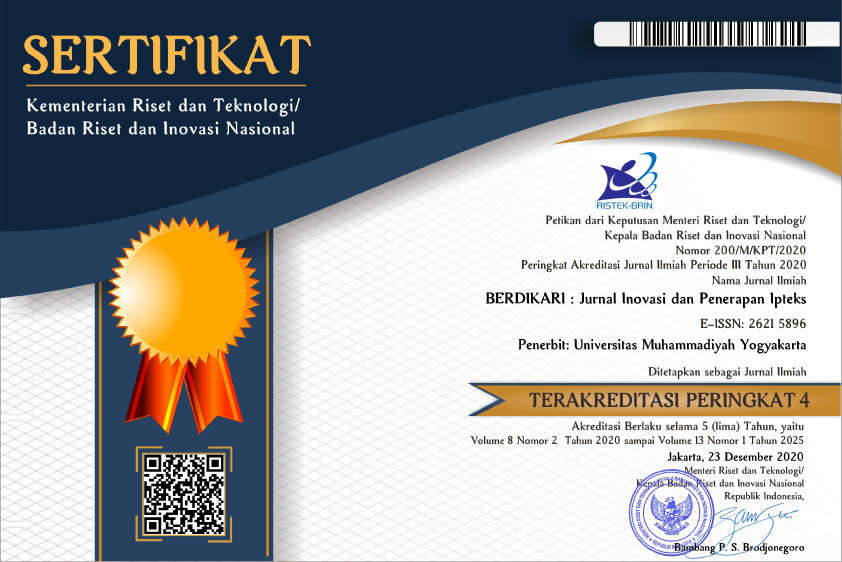Pendekatan Klinis Perawatan Indirect Pulp Capping bagi Pelajar
DOI:
https://doi.org/10.18196/berdikari.v11i2.18238Keywords:
teeth, caries, curative, pulp cappingAbstract
Cavities or caries are diseases of the hard tissue of the teeth. The presence of caries must not be ignored and must be treated because carious lesions can spread and result in pain, tooth loss, and infection of the tissues supporting the teeth. This community service activity aims to increase public awareness of dental and oral health through curative efforts and evaluation of the clinical picture after indirect pulp capping treatment at the State Agricultural Development Vocational School, Ikurkoto Health Center Area, Padang City. The method used in this service begins with patient screening, pulp capping treatment, and evaluation in the form of subjective and objective examinations 1 week after treatment. Participants in the activity were 403 patients who came from around the Ikurkoto Community Health Center area. This activity found that cavities were more common in the back (posterior) teeth, especially the lower molars, as much as 80%, compared to the front (anterior) teeth, as much as 20%. The material used is a bioactive material, namely Glass Ionomer Cement (SIK) type 2 with different brands, namely Fuji II LC (type II aesthetic) 70% and Fuji IX (type II reinforced) 30%. The evaluation results after treatment showed that as many as 71% of dental patients were asymptomatic and responded well to pulp capping treatment.References
Kementrian Kesehatan RI. 2018. Laporan Nasional Riset Kesehatan Dasar (RISKESDAS) 2018. Lembaga Penerbit Badan Penelitian dan pengembangan Kesehatan 2019.
Conrads G, About I. 2018. Pathophysiology of Dental Caries. Monogr Oral Sci. 2018;27:1-10.
Pitts NB, Zero DT, Marsh PD, Ekstrand K, Weintraub JA, Ramos-Gomez F, Tagami J, Twetman S, Tsakos G, Ismail A. 2017. Dental caries. Nat Rev Dis Primers. 2017 May 25;3:17030.
Tarigan, Rasinta. 2013. Karies Gigi. Ed 2. Jakarta: EGC
Glickman, G.N., Schweitzer, J.L., 2013, Endodontic Diagnosis, Endodontics Colleagues for Excellence, AAE.,: 1-6.
Cohen Stephen, Cohen’s pathways of the Pulp, Twelveth Edition, St Louis, Missouri: Elsevier, 2020
Manu A. A., Ratu, A. R. 2019. Perilaku Pencarian Pengobatan Penyakit Gigi pada Masyarakat. Dental Therapist Journal. Vol.1, No.1, Mei 2019, pp. 1-11.
Poggio C, Beltrami R, Colombo M, Ceci M, Dagna A, Chiesa M. In vitro antibacterial activity of different pulp capping materials. J Clin Exp Dent. 2015;7(5):e584–8.
Hanafi, M.G.S., Izham, A., Harismanto, Bahtiar, E.W. 2021. BIOKOMPATIBILITAS BAHAN KAPING PULPA (Tinjauan Pustaka). Cakradonya Dent J; 13(1): 14-21
Metalita, M., Tedjosasongko, U., Nuraini, P. 2014. Indirect pulp capping in primary molar using glass ionomer cements. Dental Journal. Volume 47, Number 4, December 2014
Endodontics Collagues for Excellence. Chicago, Illinois: American Association of Endodontist, 1-8.
Heymann HO, Swift Jr EJ, Ritter AV. Sturdevant’s Art & Science of Operative Dentistry-E-Book. Elsevier Health Sciences; 2014.
Mount GJ, Hume WR, Ngo H, Wolff MS, editors. Preservation and restoration of tooth structure. Third edition. Chichester, West Sussex ; Ames, Iowa: John Wiley & Sons, Inc; 2016.
Downloads
Additional Files
Published
Issue
Section
License
Copyright
Authors retain copyright and grant BERDIKARI Jurnal Inovasi dan Penerapan IPTEK the right of first publication with the work simultaneously licensed under an Attribution 4.0 International (CC BY 4.0) that allows others to remix, adapt and build upon the work with an acknowledgment of the work's authorship and of the initial publication in BERDIKARI Jurnal Inovasi dan Penerapan IPTEK.
Authors are permitted to copy and redistribute the journal's published version of the work (e.g., post it to an institutional repository or publish it in a book), with an acknowledgment of its initial publication in BERDIKARI Jurnal Inovasi dan Penerapan IPTEK
License
Articles published in the BERDIKARI Jurnal Inovasi dan Penerapan IPTEK) are licensed under an Attribution 4.0 International (CC BY 4.0) license. You are free to:
- Share — copy and redistribute the material in any medium or format.
- Adapt — remix, transform, and build upon the material for any purpose, even commercially.
This license is acceptable for Free Cultural Works. The licensor cannot revoke these freedoms as long as you follow the license terms. Under the following terms:
- Attribution — You must give appropriate credit, provide a link to the license, and indicate if changes were made. You may do so in any reasonable manner, but not in any way that suggests the licensor endorses you or your use.
- No additional restrictions — You may not apply legal terms or technological measures that legally restrict others from doing anything the license permits.




